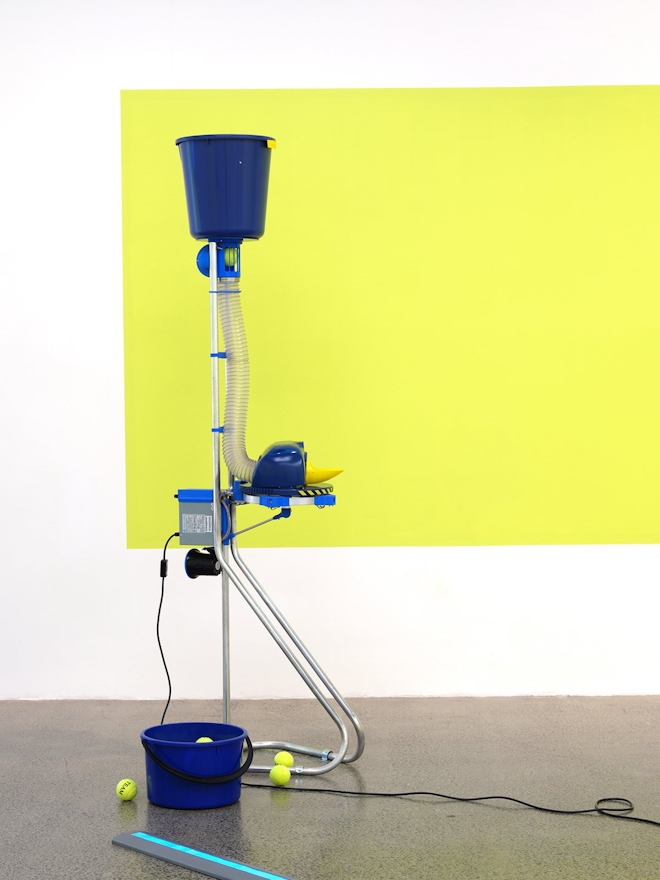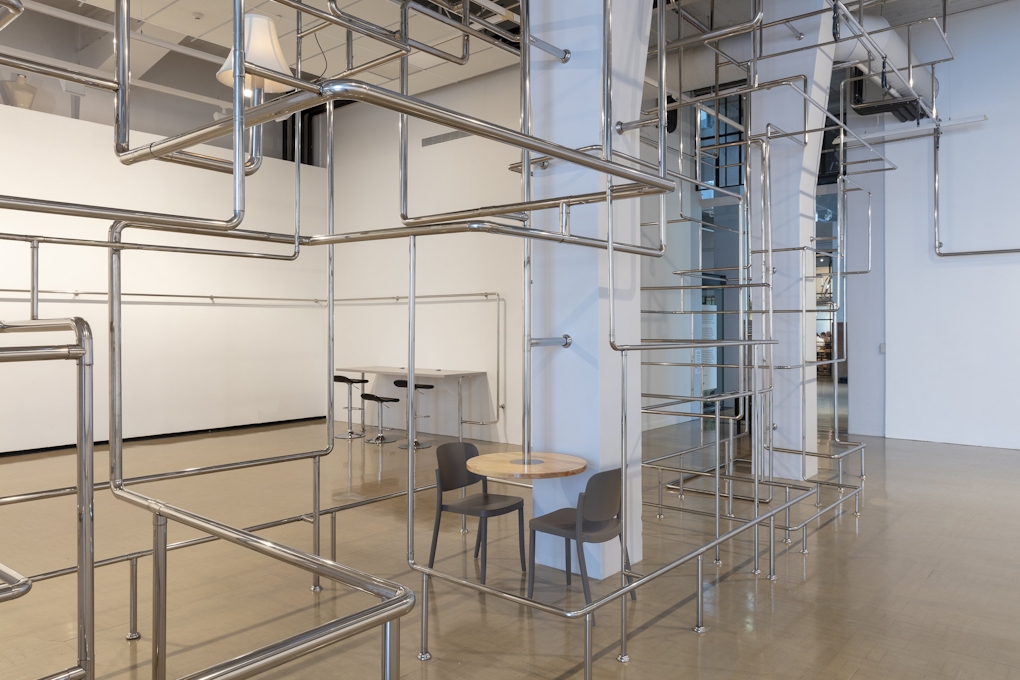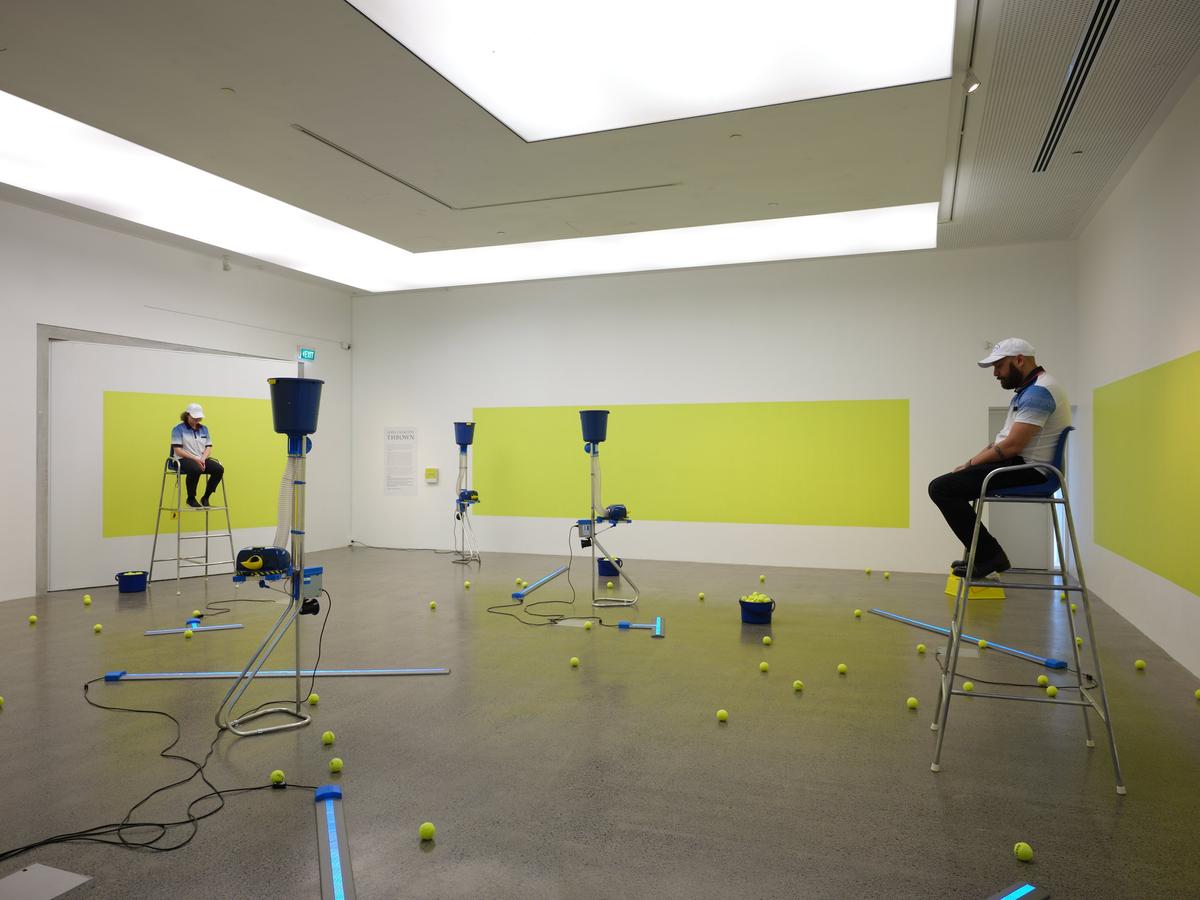If the first impression of James Charlton's THROWN is of a simple sculptural arrangement of discrete objects and light, it is not long before the installation reveals itself as something more confrontational, more provocative.
The first clue is the tennis ball fired at your chest. Move, and another yellow projectile shoots in your direction, launched by a motor spinning at 5000rpm, expelled from one of three tubular structures which occupy the gallery like vertical sentinels. On the floor, a series of LED strip lights sit like discarded elements of some forgotten technological walkway.
The gallery itself is periodically flanked by two minders, each of whom sit atop elevated chairs, reminiscent of an umpire or lifeguard. Their role is mute, watchful. As you walk across the gallery floor, a sensor is tripped, a tennis ball shoots in your direction, ricochets off the back wall and rolls along the gallery floor. After 15 shots, the attendants descend to the floor, refill the machines and the action resumes. Are these shots in anger? Is it some sort of game? If so, what are the rules? What has it got to do with you and me?

Installation Shot: James Charlton, THROWN (2020). Courtesy of Te Uru. Photo by Sam Hartnett
James Charlton is an artist whose practice is fundamentally sculptural. Yet where traditional concepts of this discipline usually give rise to surfaces both solid and soft, Charlton describes THROWN as arising from considering sculptures relationship to Object Oriented Ontology, a contemporary philosophical field which addresses the nature of objects and our relationship to them.(1)
To comprehend the urgency of this idea in 2020, consider (at the time of writing) the 30 million recorded cases of the COVID-19 virus; the necessity to acknowledge planet Earth as a sovereign being facing environmental collapse; and, looking into the not so distant future, imagine the capability of artificial intelligence to develop self-awareness. Our future depends on so much more than us.
While THROWN is the major installation presented at Te Uru, two smaller works provide vital insight into Charlton’s conceptual concerns.
In a gallery landing space, the video Catch 32 Bit (2014), shows a hand throwing a ball against a wall 32 times. As the ball bounces back, sections of the image are removed and the ball’s return to sender is hastened. Meanwhile, in the street front window of Te Uru, a sculpture of arcing strands seems infused with vectoral motion. If the video work withholds an image of the ball’s trajectory, then perhaps the sculpture manifests it. At the same time, neither work presents a static object. The object is defined only by the relationship between point A and point B.
Catch 32 Bit (2014)
Charlton is an artist who originally trained at Elam School of Fine Arts at the University of Auckland between 1979 and 1982, alongside Peter Roche, who took a similar interest in performance and sculpture. Growing up in pre-internet New Zealand led to a deep-seated frustration with lack of access to international art movements—“Art Forum always arrived six months late”.(2) Perhaps as a consequence, Charlton became deeply interested in avant-garde practice closer to home, finding an affinity with the New Zealand post-object movement, a conceptually-driven set of practices that emerged in the late 1960s and early 1970s.
Rather than pursuing the static forms of painting and sculpture, a new wave of artists became excited by the emergent disciplines of performance, moving image, sound, and accordingly, the possibility for an art motivated by relationships, exchange and movement.
Several key post-object works would become important touchstones in the development of Charlton’s practice.
Phil Dadson's 1971-72 film Earthworks was created by inviting 20 participants in both hemispheres to document their immediate surroundings on film, still photography and audio. Scheduled for the Autumn/Spring equinoxes on the 23 or 24th of September 1971 (depending on the longitude of location), the materials were sent to Dadson by post, and over several months he collaged the materials into a single 16mm film. Taking in locations as diverse as Greenland, San Francisco and the central North Island volcanic plateau, Earthworks was subtitled “a temporary instant in the continuum of universal ebb and flow” and “dedicated to peaceful celebration of planet Earth and Universe.”(3)
Phil Dadson, EARTHWORKS (1971/72)
In 1974, Jim Allen presented Contact, a three-part performance at the Govett-Brewster Art Gallery in New Plymouth. Setting up simultaneous performance zones featuring multiple participants, Allen presented a multi-faceted exploration of sensory awareness, technology and exchange. The first piece, Computer Dance, involved blind-folded individuals using infra-red transmitters to "make contact." Parangole Capes began with a group of "tightly bound" participants who worked to set each other free. Finally, Body Articulation/Imprint culminated in performers exploring the body through movement and bright paint.(4)
Both Allen (b.1922) and Dadson (b.1946) have been highly influential figures for generations of New Zealand artists, not only via their practice but also through their teaching, with Allen as head of the Elam School of Fine Arts Sculpture Department, and Dadson later setting up the Intermedia Department in the same faculty. Just as these artists became mentors for Charlton, in turn Charlton would return the favour, supporting Allen to re-stage Contact at the Govett-Brewster in 2010, and contributing technical assistance to realise Dadson’s ongoing project Bodytok (2006-). Despite his affinity for the New Zealand post-object movement, Charlton spent much of the 1980s in the United States of America where he exhibited as a sculptor. He returned to New Zealand in 1991, and in 1993, his work was included in the exhibition Art Now, curated by Christina Barton at the Museum of New Zealand, Te Papa Tongarewa. The show presented a roll call of artists who would come to be seen as leading New Zealand contemporary artists over the next three decades, including: Peter Robinson, Jacqueline Fraser, Michael Parekowhai, Joyce Campbell, Julian Dashper, Ruth Watson, Maureen Lander, Brett Graham, Peter Roche and Derrick Cherrie.
Charlton’s own work in Art Now, entitled I Listen (1993), consisted of five crystal set radios mounted inside glass vitrines, each tuned to a different talk-back radio show which could be listened to by using the earpiece provided. Much like his other gallery-based work in the 1980s and 90s, it was sculptural in nature but informed by the post-object engagement with interactivity and relationships.
In the 2000s, Charlton began to stage a series of comparatively modest performance works in site-specific locations, developing new conceptual concerns. In nCompass (2013), Charlton walked beside a section of the Berlin Wall balancing a 2.6m pole on his head, which was fitted with a digital compass.(5) If the pole deviated from a parallel bearing to the wall, lights at the end of the object switched off. In the face of the pole’s natural desire to follow gravity, and the inevitable fatigue of the human performer, the task was an exercise in futility.
nCompass (2013) James Charlton
Each of these works hinged on a central premise—that in between the Bounce and the Catch there exists a discrete event that cannot be contained by the human agent; something which exists independently from an artist or audience; a discreet digital event that exists outside of perception but which, nevertheless, is taken as a given.
In another 2013 performance titled iForm, Charlton asked 10 people to meet at a central point on a circular bus stop. Using a GPS signal, he traced each individual’s movement on their respective journeys outward from the starting location. Charlton gauged the distance between participants to construct a digital sculptural form, a singular image which represented not the topography of the space, but a form created by the participants’ distance between each other.(6)
If nCompass signaled a clear interest in object ontology, iForm augmented this practice through a radical concept of "the digital", first proposed in 1971 by American mathematician and philosopher David Lewis (1941-2001). Lewis suggested that where "analogue" is information that unfurls in an unbroken stream, "digital" is information organised as discrete parcels, stacked on top of one another, or side by side.(7) By this definition "digital" is liberated from a computer-specific concept, and instead becomes a proposal for imagining space and relationships. These ideas would be explored further by Charlton in a doctorate completed at Plymouth University in 2017. When Charlton returned to public art making, his practice put these same concepts into action, but took a new turn to critique the gallery. Importantly, also, Charlton’s practice now also had a role for the viewer.
First exhibited in 2017 at the Exhibition Research Centre, Liverpool, Catch/Bounce featured five works.(8) Each of these works hinged on a central premise—that in between the Bounce and the Catch there exists a discrete event that cannot be contained by the human agent; something which exists independently from an artist or audience; a discreet digital event that exists outside of perception but which, nevertheless is taken as a given.
In Hand was a series of photographs of a pigeon, caught in a city square and then banded with a simple blue leg band. The pigeon was photographed using an instant polaroid camera before being released. Deliberately extending the exhibition beyond the confines of the gallery, In Hand asked what an image could signal, beyond a snapshot in time. Likewise, for In Receipt the audience was invited to swipe their bankcard through a card reader. After a short wait, the viewer received a numbered receipt upon which was printed excerpts of an essay by Charlton. While it was theoretically possible to piece the essay together by assembling the other numbered receipts issued to visitors throughout the shows run, much like in nCompass, In Receipt presented a set of relationships that were ultimately impossible to fulfill.
The showpiece of Catch/Bounce was Drop, a collection of 20 basketballs attached to a length of cord which dangled from an overhead series of release mechanisms, not unlike the machine shooters in THROWN. Periodically the balls would dramatically drop to the floor, then return to their cradle though a movement so imperceptible as to be unseen, unless the viewer walked away and turned back later to realise the difference.
-James-Charlton.jpg)
Installation view of Drop (2017) James Charlton, as part of the installation Catch I Bounce, Exhibition Research Lab, Liverpool, UK (2017)
THROWN continues this line of investigation, but further provokes the viewer to consider their own role in larger systems of capital and influence. Such a gesture finds resonance with contemporary Aotearoa artists like Yona Lee, whose practice, whilst ostensibly based on architecture, leads us away from utilitarian value, and into dead ends and non-spaces. Amongst Lee’s expansive sculptural networks of pipes and railings are oddly disconnected domestic items of furniture and fittings, misplaced objects that suggest a system gone wrong. If Lee’s work presents as comic surrealism, it also warns against mutant systems of power. Similarly, Charlton's THROWN trades in a stoic absurdism, but in the seemingly random volley of the tennis balls, the subservience of the ball people to the machines, the hierarchical separation of ball person and viewer, there are uneasy questions about power, control and loss of agency.

Installation view of In Transit (2018) Yona Lee, City Gallery Wellington (2018)
In the lead-up to THROWN, when Charlton was finishing his construction of the exhibition materials, Auckland was put into a second COVID-19 lockdown. Thus, where the research for this essay might have been informed by studio visits, it took place as a video call on the Zoom platform, and Charlton sending video of the machines in action; our social interactions redrawn and mediated by technology.
This is only the latest challenge in humanity's immediate present. While Catch/Bounce dealt with subtle movement, presence and absence, THROWN is direct and urgent. We are now in an era where we are forced to recalibrate our day-to-day lives to include the agency, not just of a malignant virus but of the planetary ecosystem as, day by day, it collapses. Likewise, just as Allen's Contact questioned the mediating role of technology in human relationships, artificial intelligence looms as the new fabric in every materiality and every human exchange. And although some would deny the sovereignty of the ecosystem, and even of human beings themselves, Yona Lee's work foreshadows the potential outcome as a distorted irreversible mutation of form and function. Finally, just as Dadson's Earthworks was “dedicated to peace on planet Earth”, Charlton's THROWN is also a provocation to action; this is not a time for neglect, or to turn a blind eye to what is around us, it is a time for engagement. Let's mobilise.
__________
Originally published on the occasion of: James Charlton: THROWN, 3 October–29 November 2020 at Te Uru Waitākere Contemporary Gallery, Auckland, New Zealand. Reprinted with permission. Thanks to James Charlton, Chloe Geoghegan, Andrew Clifford.
